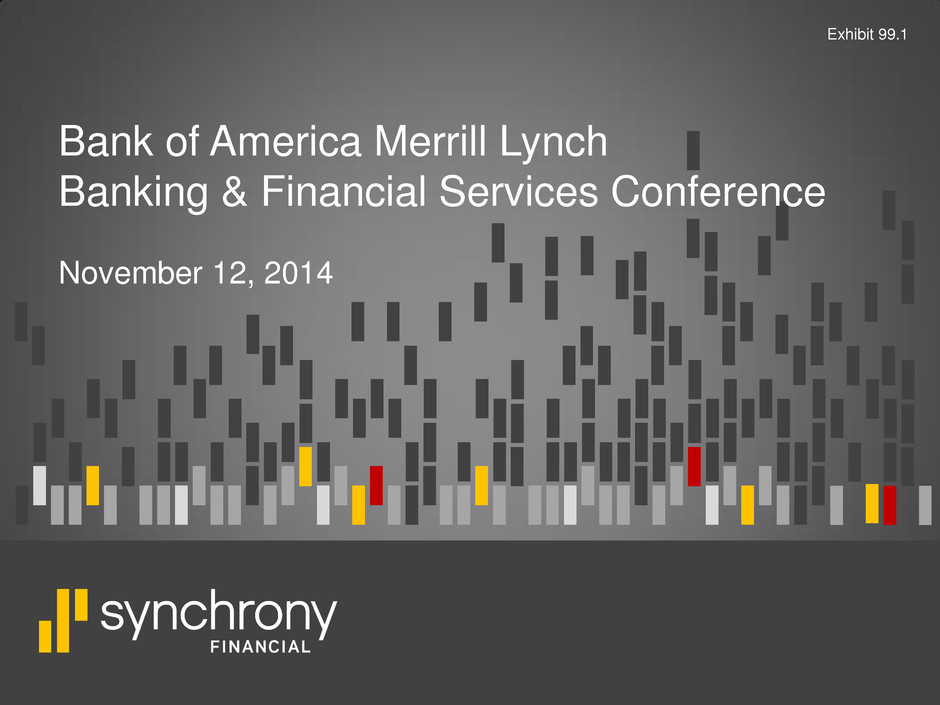
Bank of America Merrill Lynch Banking & Financial Services Conference November 12, 2014 Exhibit 99.1
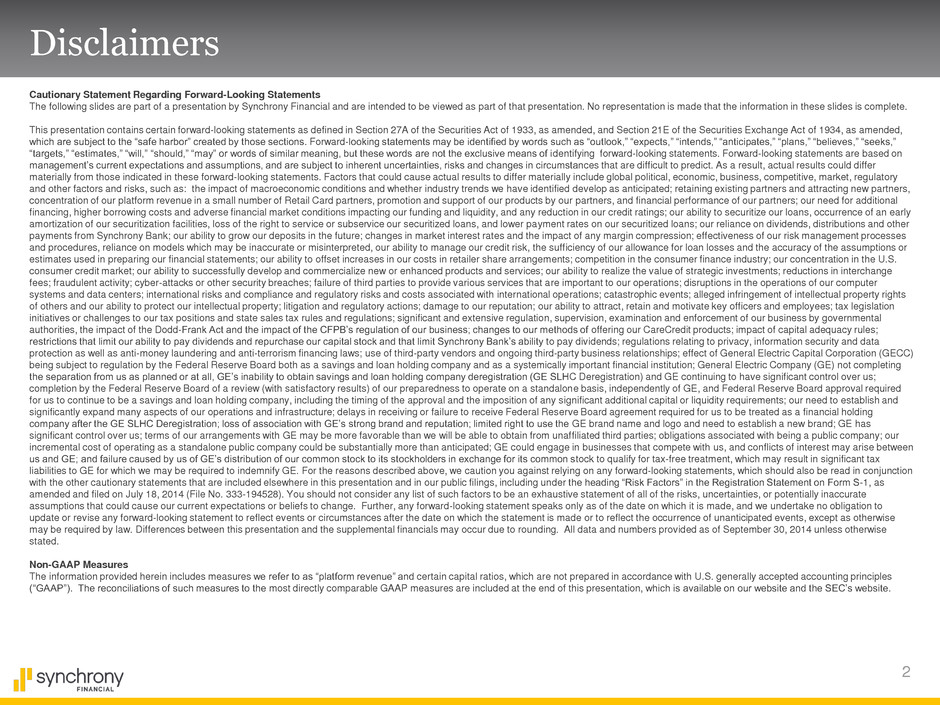
2 Cautionary Statement Regarding Forward-Looking Statements The following slides are part of a presentation by Synchrony Financial and are intended to be viewed as part of that presentation. No representation is made that the information in these slides is complete. This presentation contains certain forward-looking statements as defined in Section 27A of the Securities Act of 1933, as amended, and Section 21E of the Securities Exchange Act of 1934, as amended, which are subject to the “safe harbor” created by those sections. Forward-looking statements may be identified by words such as “outlook,” “expects,” “intends,” “anticipates,” “plans,” “believes,” “seeks,” “targets,” “estimates,” “will,” “should,” “may” or words of similar meaning, but these words are not the exclusive means of identifying forward-looking statements. Forward-looking statements are based on management’s current expectations and assumptions, and are subject to inherent uncertainties, risks and changes in circumstances that are difficult to predict. As a result, actual results could differ materially from those indicated in these forward-looking statements. Factors that could cause actual results to differ materially include global political, economic, business, competitive, market, regulatory and other factors and risks, such as: the impact of macroeconomic conditions and whether industry trends we have identified develop as anticipated; retaining existing partners and attracting new partners, concentration of our platform revenue in a small number of Retail Card partners, promotion and support of our products by our partners, and financial performance of our partners; our need for additional financing, higher borrowing costs and adverse financial market conditions impacting our funding and liquidity, and any reduction in our credit ratings; our ability to securitize our loans, occurrence of an early amortization of our securitization facilities, loss of the right to service or subservice our securitized loans, and lower payment rates on our securitized loans; our reliance on dividends, distributions and other payments from Synchrony Bank; our ability to grow our deposits in the future; changes in market interest rates and the impact of any margin compression; effectiveness of our risk management processes and procedures, reliance on models which may be inaccurate or misinterpreted, our ability to manage our credit risk, the sufficiency of our allowance for loan losses and the accuracy of the assumptions or estimates used in preparing our financial statements; our ability to offset increases in our costs in retailer share arrangements; competition in the consumer finance industry; our concentration in the U.S. consumer credit market; our ability to successfully develop and commercialize new or enhanced products and services; our ability to realize the value of strategic investments; reductions in interchange fees; fraudulent activity; cyber-attacks or other security breaches; failure of third parties to provide various services that are important to our operations; disruptions in the operations of our computer systems and data centers; international risks and compliance and regulatory risks and costs associated with international operations; catastrophic events; alleged infringement of intellectual property rights of others and our ability to protect our intellectual property; litigation and regulatory actions; damage to our reputation; our ability to attract, retain and motivate key officers and employees; tax legislation initiatives or challenges to our tax positions and state sales tax rules and regulations; significant and extensive regulation, supervision, examination and enforcement of our business by governmental authorities, the impact of the Dodd-Frank Act and the impact of the CFPB’s regulation of our business; changes to our methods of offering our CareCredit products; impact of capital adequacy rules; restrictions that limit our ability to pay dividends and repurchase our capital stock and that limit Synchrony Bank’s ability to pay dividends; regulations relating to privacy, information security and data protection as well as anti-money laundering and anti-terrorism financing laws; use of third-party vendors and ongoing third-party business relationships; effect of General Electric Capital Corporation (GECC) being subject to regulation by the Federal Reserve Board both as a savings and loan holding company and as a systemically important financial institution; General Electric Company (GE) not completing the separation from us as planned or at all, GE’s inability to obtain savings and loan holding company deregistration (GE SLHC Deregistration) and GE continuing to have significant control over us; completion by the Federal Reserve Board of a review (with satisfactory results) of our preparedness to operate on a standalone basis, independently of GE, and Federal Reserve Board approval required for us to continue to be a savings and loan holding company, including the timing of the approval and the imposition of any significant additional capital or liquidity requirements; our need to establish and significantly expand many aspects of our operations and infrastructure; delays in receiving or failure to receive Federal Reserve Board agreement required for us to be treated as a financial holding company after the GE SLHC Deregistration; loss of association with GE’s strong brand and reputation; limited right to use the GE brand name and logo and need to establish a new brand; GE has significant control over us; terms of our arrangements with GE may be more favorable than we will be able to obtain from unaffiliated third parties; obligations associated with being a public company; our incremental cost of operating as a standalone public company could be substantially more than anticipated; GE could engage in businesses that compete with us, and conflicts of interest may arise between us and GE; and failure caused by us of GE’s distribution of our common stock to its stockholders in exchange for its common stock to qualify for tax-free treatment, which may result in significant tax liabilities to GE for which we may be required to indemnify GE. For the reasons described above, we caution you against relying on any forward-looking statements, which should also be read in conjunction with the other cautionary statements that are included elsewhere in this presentation and in our public filings, including under the heading “Risk Factors” in the Registration Statement on Form S-1, as amended and filed on July 18, 2014 (File No. 333-194528). You should not consider any list of such factors to be an exhaustive statement of all of the risks, uncertainties, or potentially inaccurate assumptions that could cause our current expectations or beliefs to change. Further, any forward-looking statement speaks only as of the date on which it is made, and we undertake no obligation to update or revise any forward-looking statement to reflect events or circumstances after the date on which the statement is made or to reflect the occurrence of unanticipated events, except as otherwise may be required by law. Differences between this presentation and the supplemental financials may occur due to rounding. All data and numbers provided as of September 30, 2014 unless otherwise stated. Non-GAAP Measures The information provided herein includes measures we refer to as “platform revenue” and certain capital ratios, which are not prepared in accordance with U.S. generally accepted accounting principles (“GAAP”). The reconciliations of such measures to the most directly comparable GAAP measures are included at the end of this presentation, which is available on our website and the SEC’s website. Disclaimers
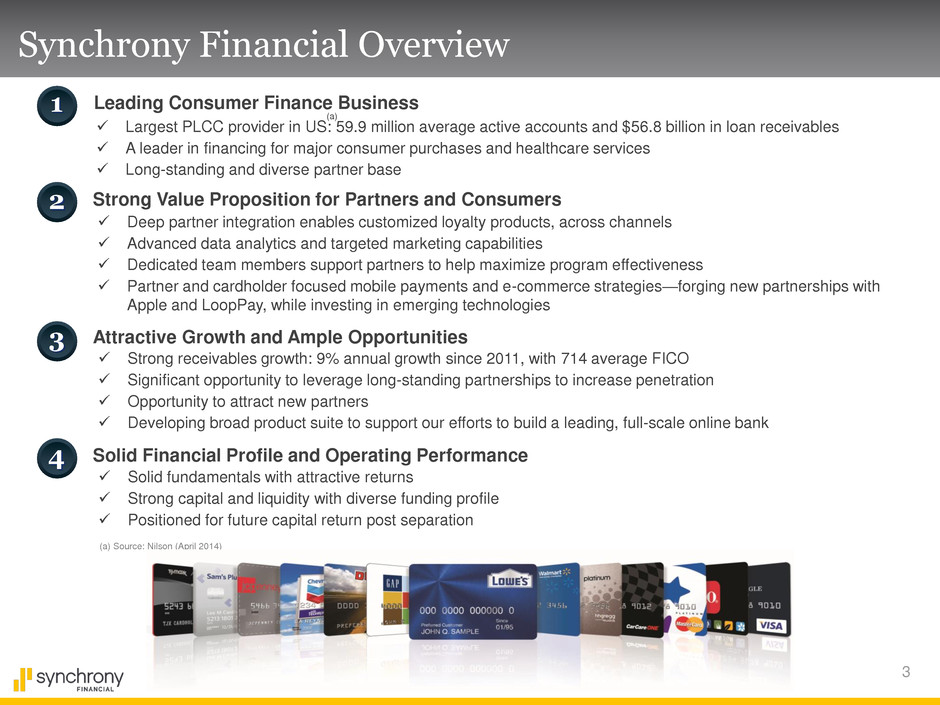
3 (a) Source: Nilson (April 2014) Synchrony Financial Overview Strong Value Proposition for Partners and Consumers 2 Deep partner integration enables customized loyalty products, across channels Advanced data analytics and targeted marketing capabilities Dedicated team members support partners to help maximize program effectiveness Partner and cardholder focused mobile payments and e-commerce strategies—forging new partnerships with Apple and LoopPay, while investing in emerging technologies Attractive Growth and Ample Opportunities 3 Strong receivables growth: 9% annual growth since 2011, with 714 average FICO Significant opportunity to leverage long-standing partnerships to increase penetration Opportunity to attract new partners Developing broad product suite to support our efforts to build a leading, full-scale online bank Solid Financial Profile and Operating Performance 4 Solid fundamentals with attractive returns Strong capital and liquidity with diverse funding profile Positioned for future capital return post separation Leading Consumer Finance Business Largest PLCC provider in US: 59.9 million average active accounts and $56.8 billion in loan receivables A leader in financing for major consumer purchases and healthcare services Long-standing and diverse partner base (a) 1
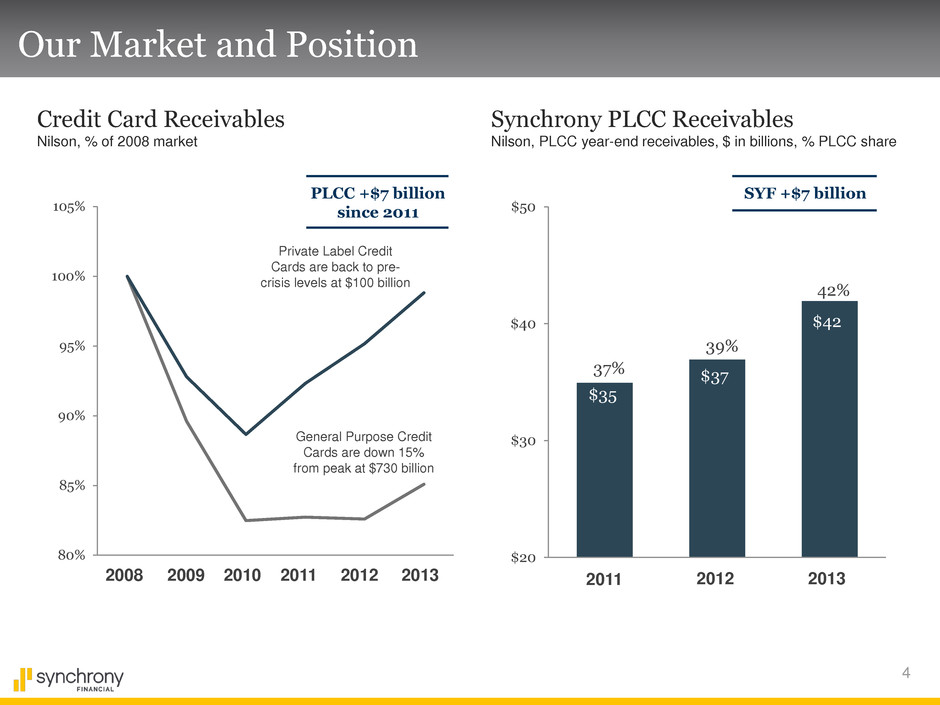
4 $20 $30 $40 $50 Our Market and Position Credit Card Receivables Nilson, % of 2008 market 80% 85% 90% 95% 100% 105% Private Label Credit Cards are back to pre- crisis levels at $100 billion General Purpose Credit Cards are down 15% from peak at $730 billion 2008 2009 2010 2011 2012 2013 Synchrony PLCC Receivables Nilson, PLCC year-end receivables, $ in billions, % PLCC share $42 $35 $37 SYF +$7 billion PLCC +$7 billion since 2011 2013 2011 2012 42% 37% 39%
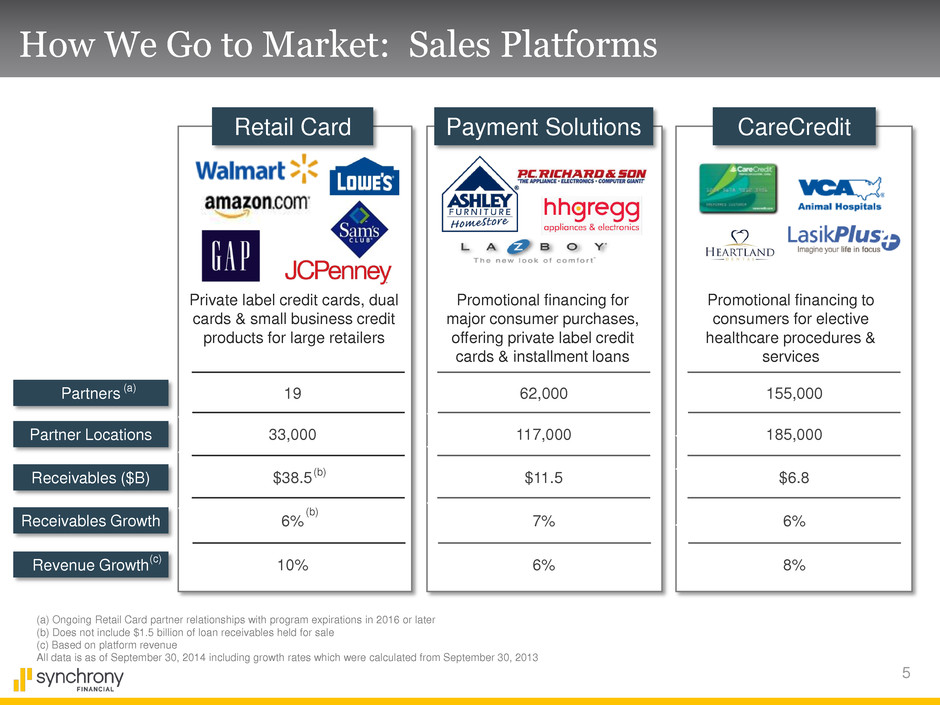
5 How We Go to Market: Sales Platforms Payment Solutions Retail Card CareCredit Private label credit cards, dual cards & small business credit products for large retailers Promotional financing for major consumer purchases, offering private label credit cards & installment loans Promotional financing to consumers for elective healthcare procedures & services Partners Partner Locations Receivables ($B) (a) Ongoing Retail Card partner relationships with program expirations in 2016 or later (b) Does not include $1.5 billion of loan receivables held for sale (c) Based on platform revenue All data is as of September 30, 2014 including growth rates which were calculated from September 30, 2013 (a) 19 33,000 $38.5 62,000 117,000 $11.5 155,000 185,000 $6.8 Receivables Growth 6% 7% 6% (b) 10% 6% 8% Revenue Growth (c) (b)
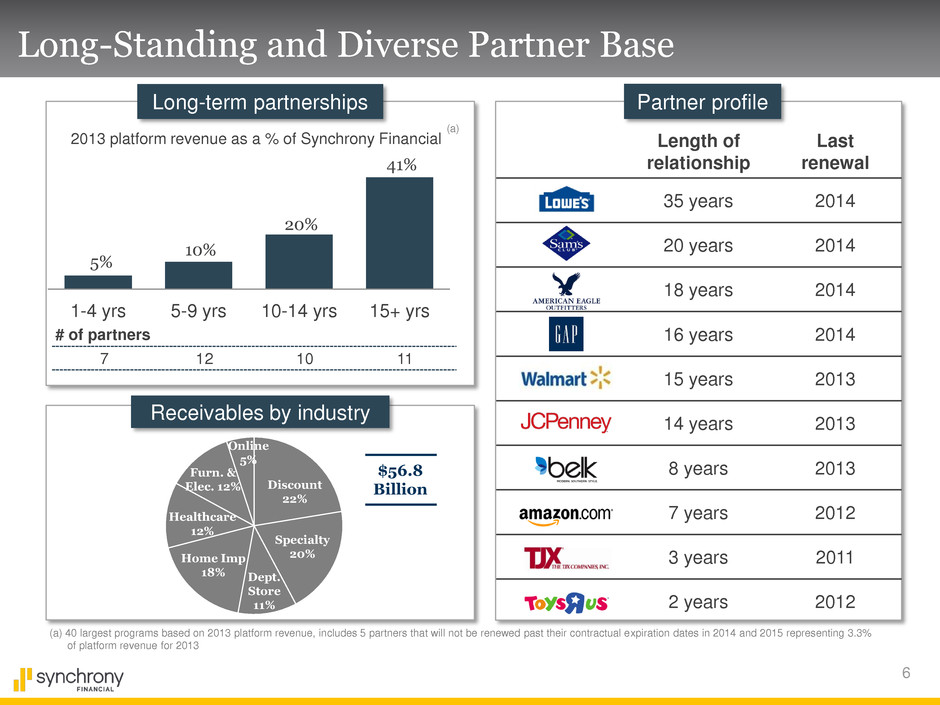
6 $56.8 Billion Long-Standing and Diverse Partner Base 1-4 yrs 5-9 yrs 10-14 yrs 15+ yrs (a) 40 largest programs based on 2013 platform revenue, includes 5 partners that will not be renewed past their contractual expiration dates in 2014 and 2015 representing 3.3% of platform revenue for 2013 Long-term partnerships 7 12 10 11 # of partners 2013 platform revenue as a % of Synchrony Financial Length of relationship Last renewal 35 years 2014 20 years 2014 18 years 2014 16 years 2014 15 years 2013 14 years 2013 8 years 2013 7 years 2012 3 years 2011 2 years 2012 Partner profile (a) 5% 10% 20% 41% Discount 22% Specialty 20% Dept. Store 11% Home Imp 18% Healthcare 12% Online 5% Furn. & Elec. 12% Receivables by industry
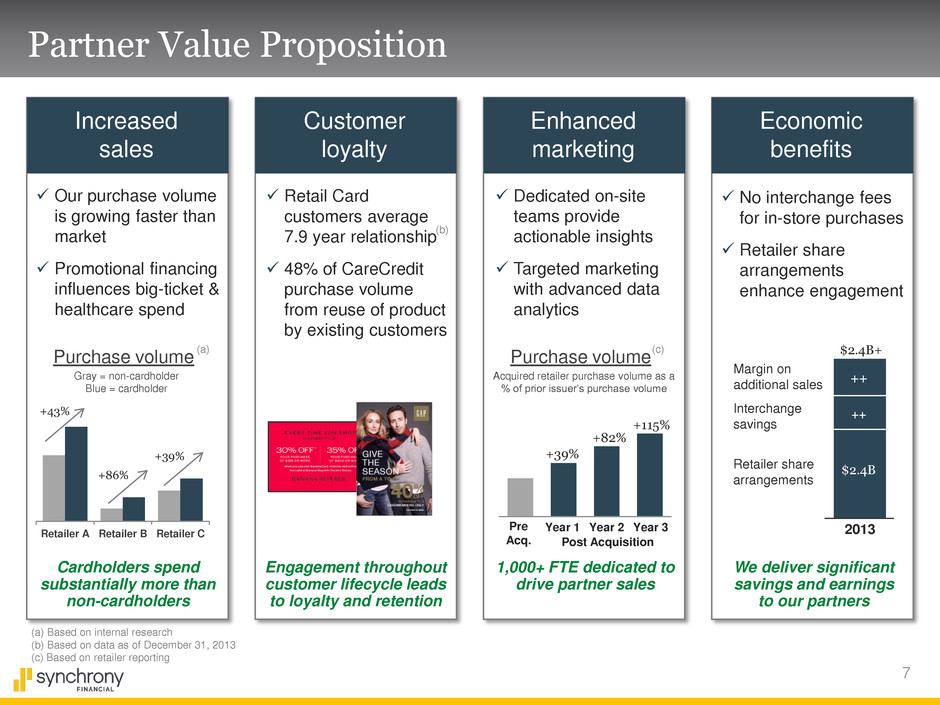
7 Partner Value Proposition We deliver significant savings and earnings to our partners No interchange fees for in-store purchases Retailer share arrangements enhance engagement Interchange savings Retailer share arrangements Margin on additional sales $2.4B ++ ++ $2.4B+ 2013 Economic benefits (a) Based on internal research (b) Based on data as of December 31, 2013 (c) Based on retailer reporting Engagement throughout customer lifecycle leads to loyalty and retention Retail Card customers average 7.9 year relationship 48% of CareCredit purchase volume from reuse of product by existing customers Customer loyalty 1,000+ FTE dedicated to drive partner sales Dedicated on-site teams provide actionable insights Targeted marketing with advanced data analytics Enhanced marketing Purchase volume (c) Acquired retailer purchase volume as a % of prior issuer’s purchase volume Cardholders spend substantially more than non-cardholders Our purchase volume is growing faster than market Promotional financing influences big-ticket & healthcare spend Increased sales Purchase volume (a) Retailer A Retailer B Retailer C +43% +86% +39% +39% +82% Pre Acq. Year 1 Gray = non-cardholder Blue = cardholder (b) Year 2 Year 3 Post Acquisition +115%

8 Availability of credit differentiates partners & helps customers Significant acquisition & lifecycle benefits vs General Purpose Convenient credit & acquisition offer is a compelling proposition 60 million average active cardholders enjoying our card benefits Millions approved every year Rewards tailored to each customer Making purchases & procedures obtainable 38 42 2012 2011 2013 47 Annual applications (in millions) Customer Value Proposition Other payment Postpone 47% 53% 47% of CareCredit customers would postpone or reduce scope of treatment without financing Instant access to credit Promotions & rewards Promotional financing +12% 5% - 40% 1% - 10% Synchrony rewards value Up to 5% 1% - 2% General Purpose cash back Promo Everyday (b) Source: 2014 CareCredit Internal Study (1,501 respondents) Promo Everyday (b) (a) Based on terms of ten general purpose cash back credit cards surveyed by the Company (a)

9 Leveraging Data to Differentiate Our Value Proposition Transactions on our closed loop network vs. general purpose Customer Merchant Acquirer Network Issuer General Purpose Card PLCC Card Date Merch. Channel Brand Cat./SKU $ 1/2/14 Belk In- Store DKNY Women’s shoes 468XUTY $83.44 1/9/14 Belk Mobile Coach Women’s handbags 229HHREO $212.17 Enables customized offers SKU and category offers Synchrony’s more robust data provides insight Illustrative PLCC customer transactions Date Merch. Channel Brand Cat./SKU $ 1/2/14 Belk $83.44 1/9/14 Belk $212.17 General purpose transaction data Illustrative GPCC customer transactions Citi Capital One Chase

10 Mobile Payment Strategy Offer options to our cardholders Support our retailers’ mobile payments strategies Continue to provide compelling value proposition to our customers Enable EMV cards Develop cross-channel tokenization strategy for private label & Dual Card Pilot private label near field communications (NFC) standard Build and pilot proprietary solutions Invest in key technologies Identify emerging technology companies for partnerships Deliver seamless mobile capability Invest in technology & strategic partnerships Ensure security
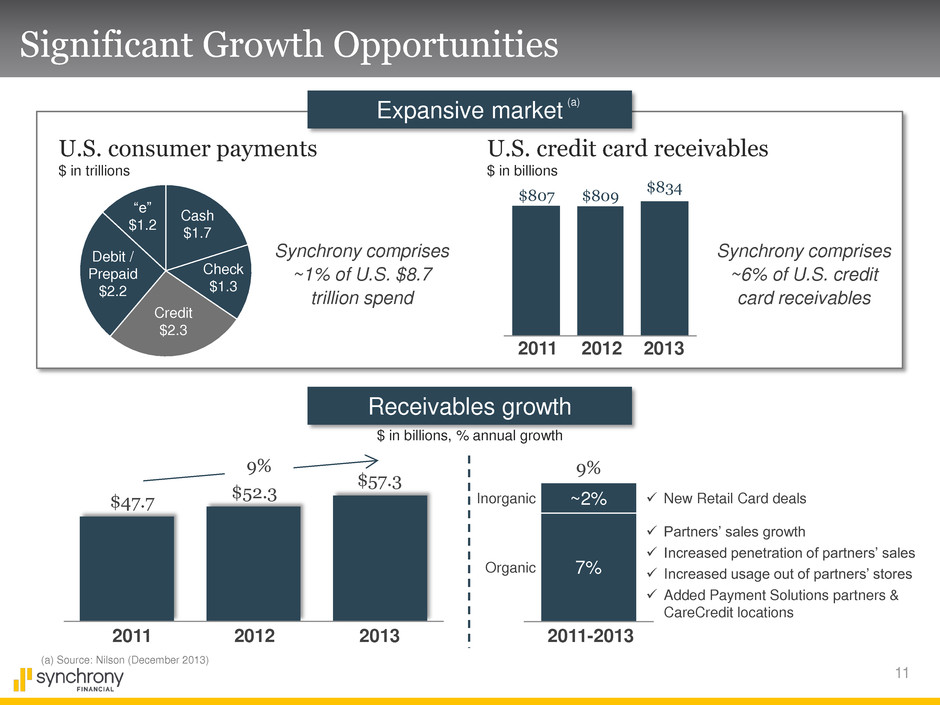
11 Significant Growth Opportunities “e” $1.2 (a) Source: Nilson (December 2013) Cash $1.7 Check $1.3 Debit / Prepaid $2.2 Credit $2.3 Synchrony comprises ~1% of U.S. $8.7 trillion spend Expansive market (a) Synchrony comprises ~6% of U.S. credit card receivables 2011 2012 2013 $807 $809 $834 Receivables growth 2011 $47.7 2012 $52.3 2013 $57.3 9% 2011-2013 9% 7% ~2% New Retail Card deals Partners’ sales growth Increased penetration of partners’ sales Increased usage out of partners’ stores Added Payment Solutions partners & CareCredit locations Inorganic Organic $ in billions, % annual growth U.S. consumer payments $ in trillions U.S. credit card receivables $ in billions
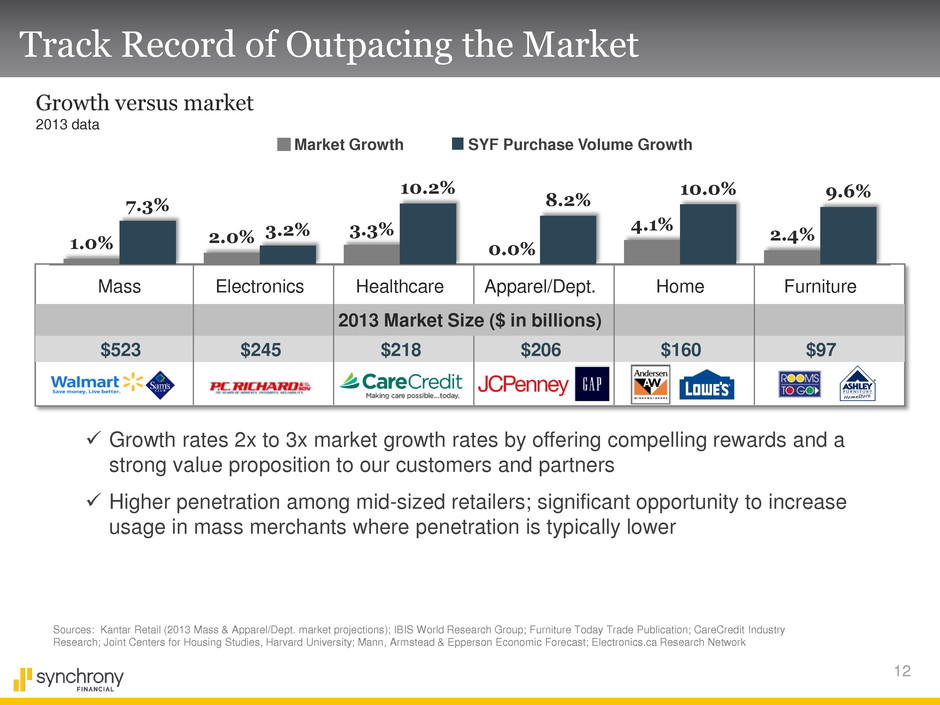
12 Track Record of Outpacing the Market $523 $245 $218 $206 $160 $97 2013 Market Size ($ in billions) Growth versus market 2013 data 1.0% 2.0% 3.3% 0.0% 4.1% 2.4% 7.3% 3.2% 10.2% 8.2% 10.0% 9.6% Mass Electronics Healthcare Apparel/Dept. Home Furniture Growth rates 2x to 3x market growth rates by offering compelling rewards and a strong value proposition to our customers and partners Higher penetration among mid-sized retailers; significant opportunity to increase usage in mass merchants where penetration is typically lower Sources: Kantar Retail (2013 Mass & Apparel/Dept. market projections); IBIS World Research Group; Furniture Today Trade Publication; CareCredit Industry Research; Joint Centers for Housing Studies, Harvard University; Mann, Armstead & Epperson Economic Forecast; Electronics.ca Research Network Market Growth SYF Purchase Volume Growth
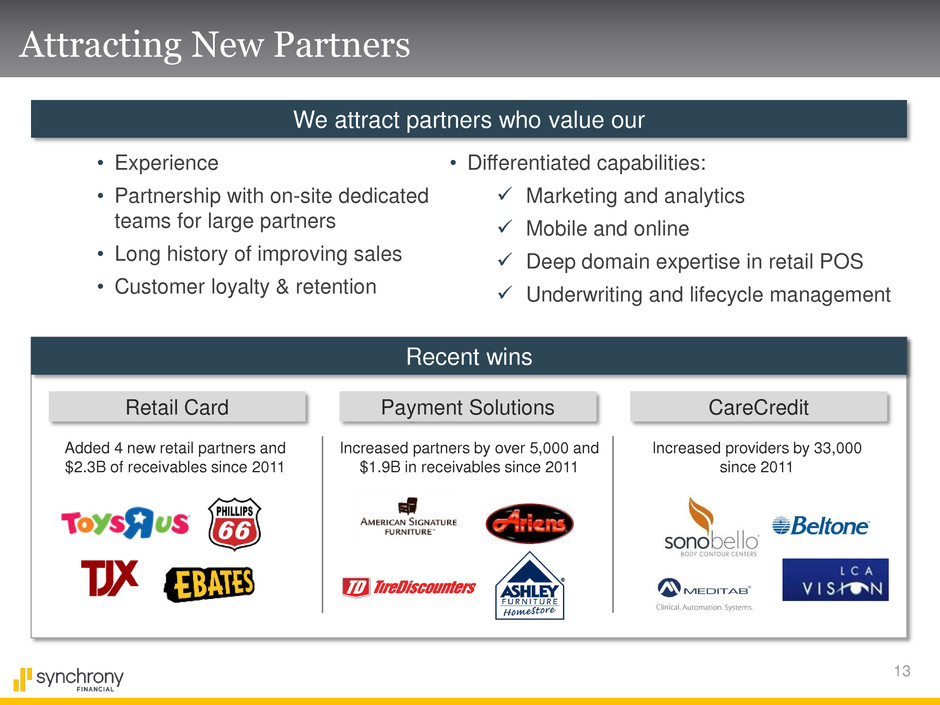
13 Attracting New Partners Added 4 new retail partners and $2.3B of receivables since 2011 Retail Card Increased partners by over 5,000 and $1.9B in receivables since 2011 Payment Solutions Increased providers by 33,000 since 2011 CareCredit • Experience • Partnership with on-site dedicated teams for large partners • Long history of improving sales • Customer loyalty & retention Recent wins • Differentiated capabilities: Marketing and analytics Mobile and online Deep domain expertise in retail POS Underwriting and lifecycle management We attract partners who value our

14 Financial Update Net earnings $ in millions 3Q’13 YTD 3Q’14 YTD Strong, stable earnings Loan receivables $ in billions 7% growth Losses Net charge-off % 4.07% 4.05% Platform revenue $ in millions $6,922 $7,410 7% growth Stable losses $1,536 $1,578 $53.3 $56.8 3Q’13 3Q’14 3Q’13 3Q’14 3Q’13 YTD 3Q’14 YTD (a) (a) Platform revenue is the sum of “interest and fees on loans,” plus “other income,” less “retailer share arrangements”. See Non-GAAP reconciliation in appendix (b) (b) Includes loan receivables held for sale
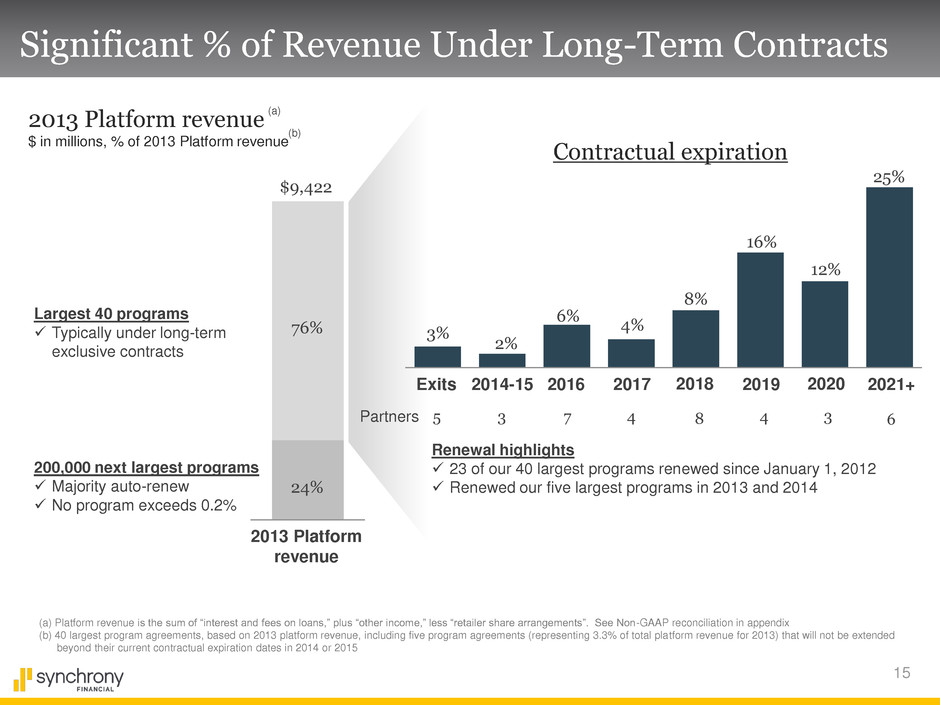
15 2013 Platform revenue 24% 76% 200,000 next largest programs Majority auto-renew No program exceeds 0.2% Significant % of Revenue Under Long-Term Contracts $9,422 Largest 40 programs Typically under long-term exclusive contracts (a) (a) Platform revenue is the sum of “interest and fees on loans,” plus “other income,” less “retailer share arrangements”. See Non-GAAP reconciliation in appendix (b) 40 largest program agreements, based on 2013 platform revenue, including five program agreements (representing 3.3% of total platform revenue for 2013) that will not be extended beyond their current contractual expiration dates in 2014 or 2015 2013 Platform revenue $ in millions, % of 2013 Platform revenue Renewal highlights 23 of our 40 largest programs renewed since January 1, 2012 Renewed our five largest programs in 2013 and 2014 (b) Contractual expiration Exits 3% 2% 6% 4% Partners 8% 16% 2017 2016 2014-15 2019 5 3 7 4 4 2018 8 12% 2020 3 25% 2021+ 6
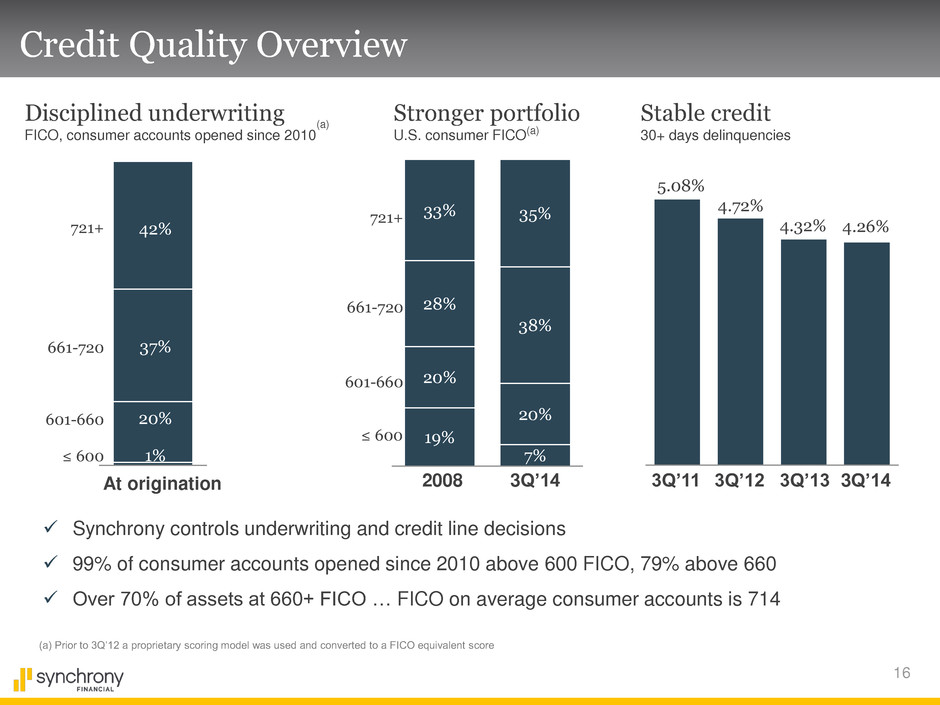
16 Credit Quality Overview Synchrony controls underwriting and credit line decisions 99% of consumer accounts opened since 2010 above 600 FICO, 79% above 660 Over 70% of assets at 660+ FICO … FICO on average consumer accounts is 714 Stronger portfolio U.S. consumer FICO Stable credit 30+ days delinquencies ≤ 600 601-660 661-720 721+ At origination Disciplined underwriting FICO, consumer accounts opened since 2010 42% 37% 20% 1% 4.72% 4.32% 4.26% 3Q’14 3Q’13 3Q’12 (a) (a) (a) Prior to 3Q’12 a proprietary scoring model was used and converted to a FICO equivalent score 5.08% 3Q’11 19% 7% 20% 20% 28% 38% 33% 35% 601-660 661-720 721+ 2008 3Q’14 ≤ 600
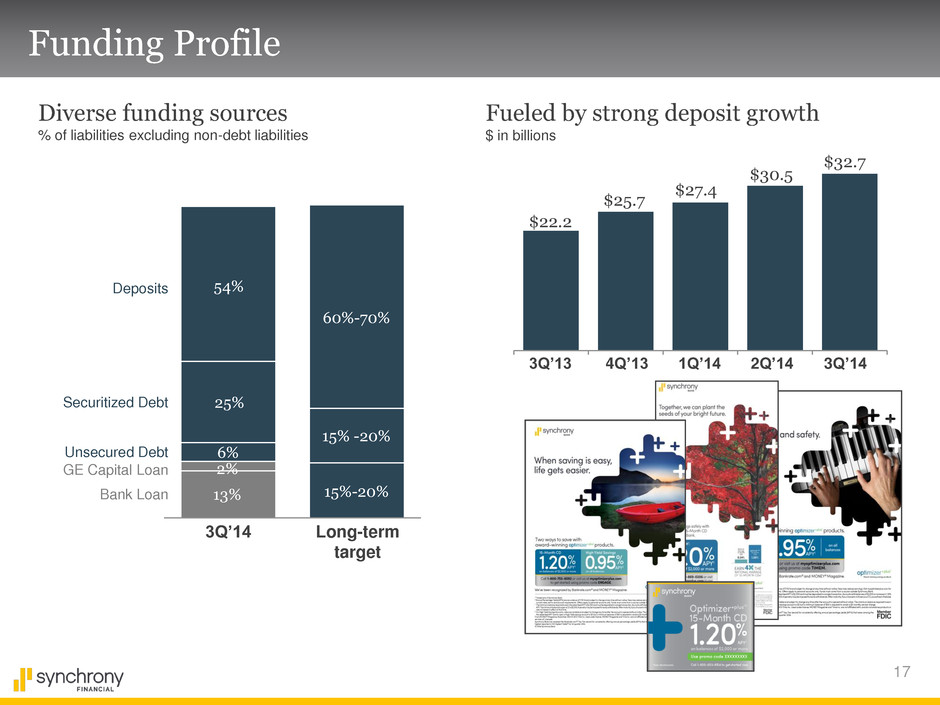
17 Funding Profile Deposits GE Capital Loan Securitized Debt Unsecured Debt 3Q’14 Long-term target 6% 54% 25% 2% 15%-20% 60%-70% 15% -20% 13% Bank Loan Diverse funding sources % of liabilities excluding non-debt liabilities Fueled by strong deposit growth $ in billions 3Q’13 1Q’14 4Q’13 $22.2 $25.7 $27.4 2Q’14 $30.5 3Q’14 $32.7

18 Peer Comparison 3Q’14 (a) Consists of net interest income plus noninterest income and includes RSAs for SYF (b) Segment data for AXP-U.S Card Services and COF-Domestic Credit Card. Other data-total company level (c) “Banks” refers to large cap regional banks which include: BBT, FITB, HBAN, KEY, PNC, RF, STI, USB, and WFC (d) Calculated as credit card yield - net charge-off rate on credit cards. SYF-total company (e) COF reported a CET1 ratio of 12.7% subject to transition provisions 31.9% 37.8% 49.0% 61.3% 61.9% SYF DFS COF Banks AXP Efficiency Ratio Risk Adjusted Yield 17.7% 11.6% 9.9% 8.5% 7.2% SYF COF DFS AXP Banks 6.8% 6.2% 5.6% -0.6% -3.6% SYF DFS AXP Banks COF Revenue Growth Liquidity % of Assets 20.6% 20.1% 16.9% 15.3% 14.2% SYF Banks AXP COF DFS 15.1% 14.8% 13.3% 12.7% 10.6% SYF DFS AXP COF Banks Tier 1 Common Ratio (g) Strong margins Significant growth Strong balance sheet Loan Receivables Growth 6.6% 6.6% 6.4% 4.7% 4.6% SYF DFS AXP Banks COF (a), (b) (f) (f) Segment data for AXP-U.S Card Services, COF-Domestic Credit Card, and DFS-Credit Card. Other data-total company level (g) For AXP, DFS, and SYF calculated as: (cash and cash equivalents + investment securities) / total assets. Others calculated as: (cash and cash equivalents + AFS securities) / total assets Sources: Company filings and SNL (e) (c) (c) (c) (c) (c) (c) (b) (d)

19 Summary Growth supported by online bank with strong deposit growth Solid fundamentals with strong returns Attractive growth opportunities, particularly to further leverage data analytics, loyalty, mobile and e-capabilities Private Label Credit Card leader well-positioned to capitalize on deep partner integration Differentiated business model with solid value proposition for both partners and consumers

Engage with us.

21 Appendix, Non-GAAP Reconciliations In order to assess and internally report the revenue performance of our three sales platforms, we use measures we refer to as “platform revenue” and “platform revenue excluding retailer share arrangements.” Platform revenue is the sum of three line items in our Condensed Consolidated and Combined Statements of Earnings prepared in accordance with GAAP: “interest and fees on loans,” plus “other income,” less “retailer share arrangements.” Platform revenue and platform revenue excluding retailer share arrangements are not measures presented in accordance with GAAP. To calculate platform revenue we deduct retailer share arrangements but do not deduct other line item expenses, such as interest expense, provision for loan losses and other expense, because those items are managed for the business as a whole. We believe that platform revenue is a useful measure to investors because it represents management’s view of the net revenue contribution of each of our platforms. Platform revenue excluding retailer share arrangements represents management’s view of the gross revenue contribution of each of our platforms. These measures should not be considered a substitute for interest and fees on loans or other measures of performance we have reported in accordance with GAAP. We present certain capital ratios. As a new savings and loan holding company, we historically have not been required by regulators to disclose capital ratios, and therefore these capital ratios are non-GAAP measures. We believe these capital ratios are useful measures to investors because they are widely used by analysts and regulators to assess the capital position of financial services companies, although our Basel I Tier 1 common ratio is not a Basel I defined regulatory capital ratio, and our Basel I and Basel III Tier 1 common ratios may not be comparable to similarly titled measures reported by other companies. Our Basel I Tier 1 common ratio is the ratio of Tier 1 common equity (as calculated below) to total risk-weighted assets as calculated in accordance with the U.S. Basel I capital rules. Our Basel III Tier 1 common ratio is the ratio of common equity Tier 1 capital to total risk-weighted assets, each as calculated in accordance with the U.S. Basel III capital rules (on a fully phased-in basis). Our Basel III Tier 1 common ratio is a preliminary estimate reflecting management’s interpretation of the final Basel III capital rules adopted in July 2013 by the Federal Reserve Board, which have not been fully implemented, and our estimate and interpretations are subject to, among other things, ongoing regulatory review and implementation guidance.
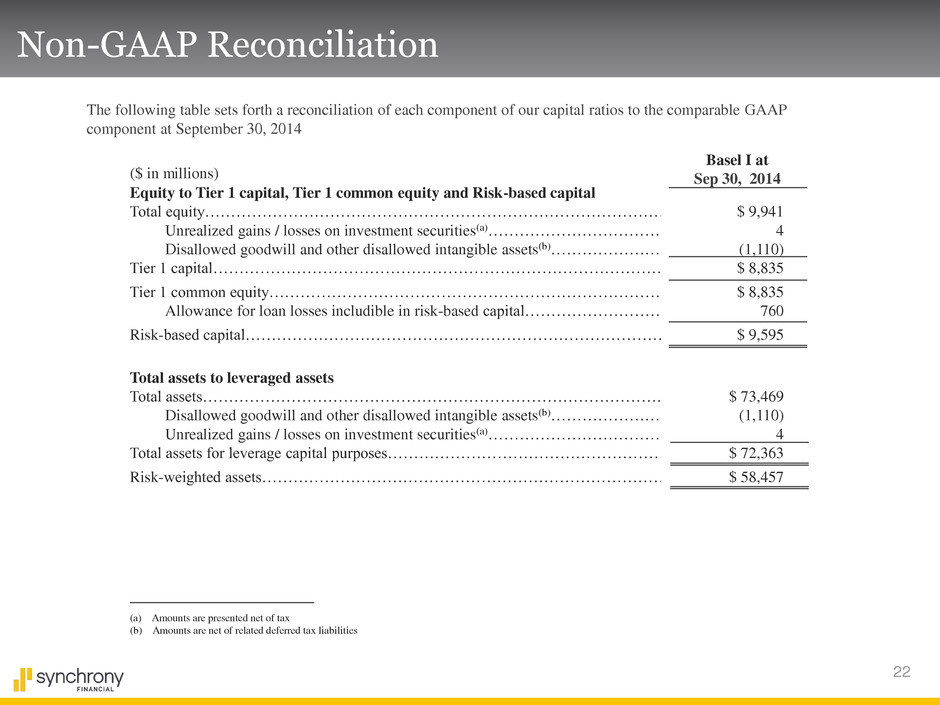
22 Non-GAAP Reconciliation Equity to Tier 1 capital, Tier 1 common equity and Risk-based capital Total equity……………………………………………………………………………………......... Unrealized gains / losses on investment securities(a)………………………………………… Disallowed goodwill and other disallowed intangible assets(b)……………………………… Tier 1 capital………………………………………………………………………………………... Tier 1 common equity……………………………………………………………………………… Allowance for loan losses includible in risk-based capital………………………………....... Risk-based capital………………………………………………………………………………….. Total assets to leveraged assets Total assets……………………………………………………………………………………......... Disallowed goodwill and other disallowed intangible assets(b)……………………………… Unrealized gains / losses on investment securities(a)………………………………………… Total assets for leverage capital purposes………………………………………………………….. Risk-weighted assets…………………………………………………………………….............. .. Basel I at Sep 30, 2014 (a) Amounts are presented net of tax (b) Amounts are net of related deferred tax liabilities The following table sets forth a reconciliation of each component of our capital ratios to the comparable GAAP component at September 30, 2014 $ 9,941 4 (1,110) $ 8,835 $ 8,835 760 $ 9,595 $ 73,469 (1,110) 4 $ 72,363 $ 58,457 ($ in millions)
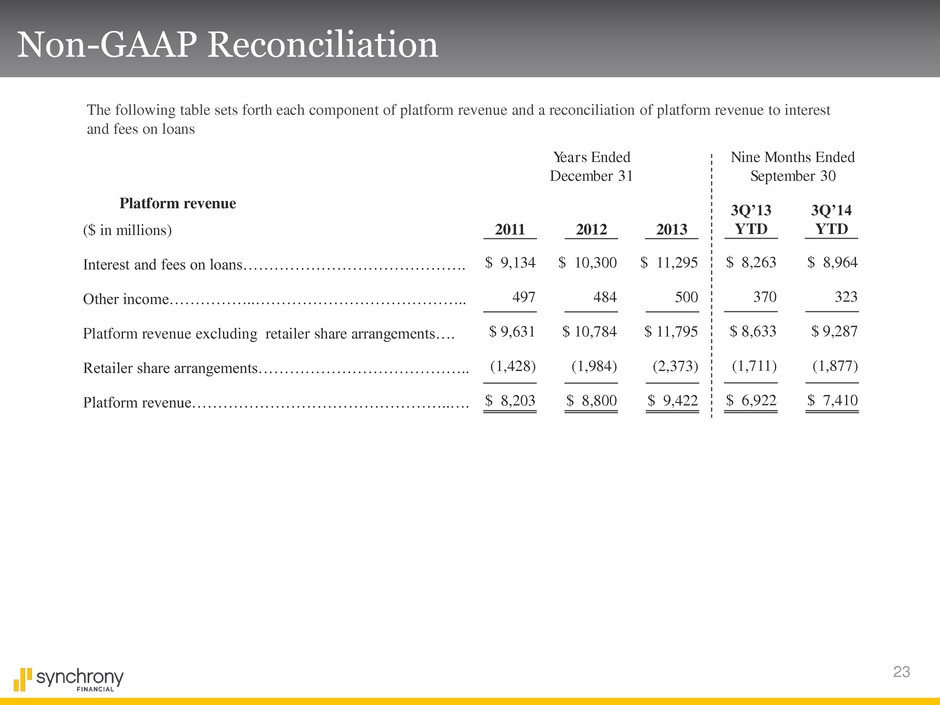
23 Non-GAAP Reconciliation ($ in millions) Interest and fees on loans……………………………………. Other income……………..………………………………….. Platform revenue excluding retailer share arrangements…. Retailer share arrangements………………………………….. Platform revenue…………………………………………..…. $ 9,134 497 $ 9,631 (1,428) $ 8,203 2011 $ 10,300 484 $ 10,784 (1,984) $ 8,800 2012 $ 11,295 500 $ 11,795 (2,373) $ 9,422 2013 The following table sets forth each component of platform revenue and a reconciliation of platform revenue to interest and fees on loans Platform revenue $ 8,263 370 $ 8,633 (1,711) $ 6,922 3Q’13 YTD $ 8,964 323 $ 9,287 (1,877) $ 7,410 3Q’14 YTD Years Ended December 31 Nine Months Ended September 30